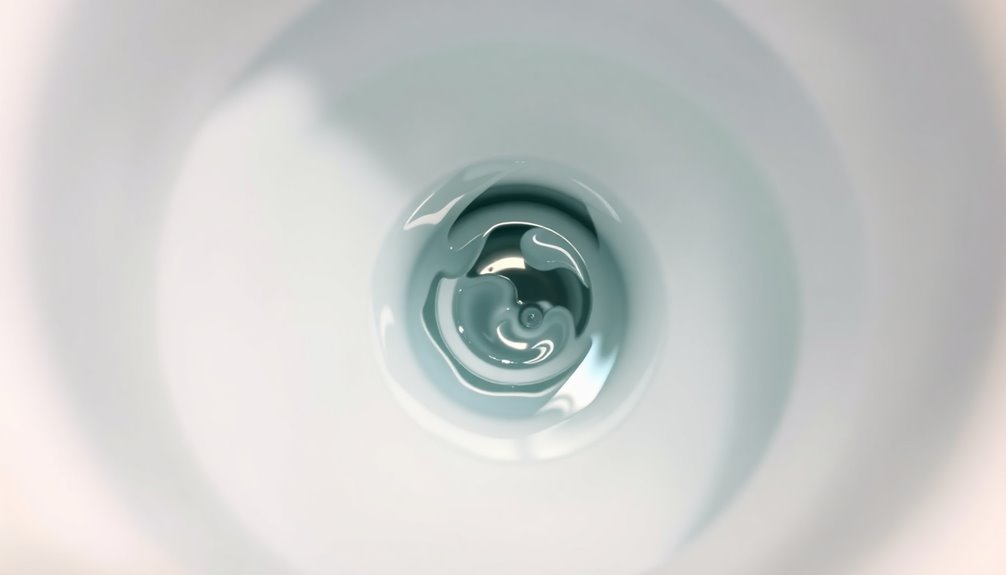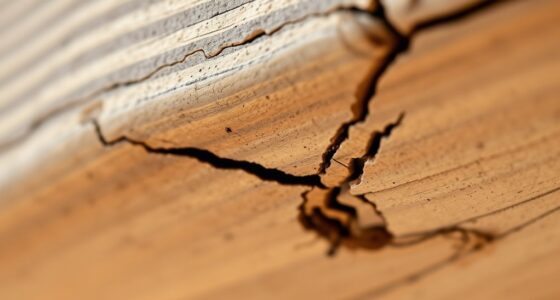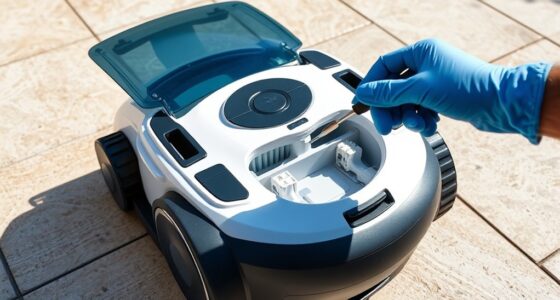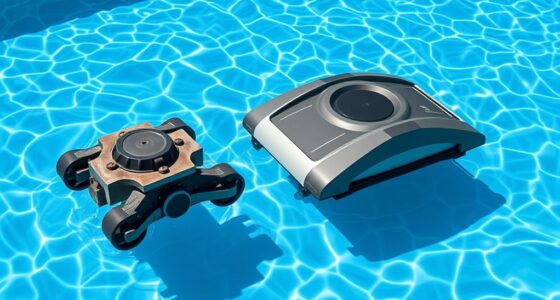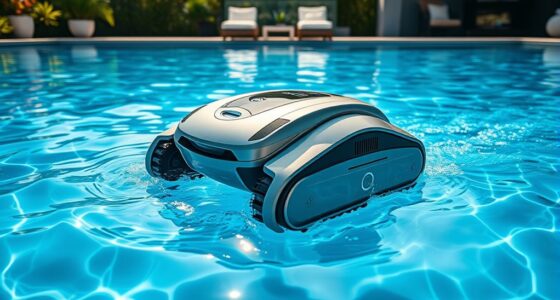Toilet water can indeed go down on its own due to gravity and the siphon effect, especially when you flush. However, issues like clogs, leaks, or cracks can prevent proper drainage and lower water levels. If you notice consistent drops in the water, you might be dealing with a faulty flapper or blockages from debris. Regular inspections and maintenance are key to keeping your plumbing in good shape. If you're curious about the various ways to address plumbing problems and guarantee your toilet functions smoothly, there's plenty more to discover regarding prevention and repairs.
Key Takeaways
- Toilet water can go down on its own due to clogged drains or blockages, causing siphoning and lowering the water level.
- Leaks from the toilet base or internal issues like faulty flappers may lead to a gradual decrease in water levels.
- Cracks in the toilet bowl can result in continuous water loss, causing the water level to drop over time.
- Regular inspections can help identify issues like leaks or clogs early, preventing significant water loss.
- Proper toilet usage and maintenance, such as avoiding flushing non-dissolvable items, can minimize water level fluctuations.
Toilet Water Behavior
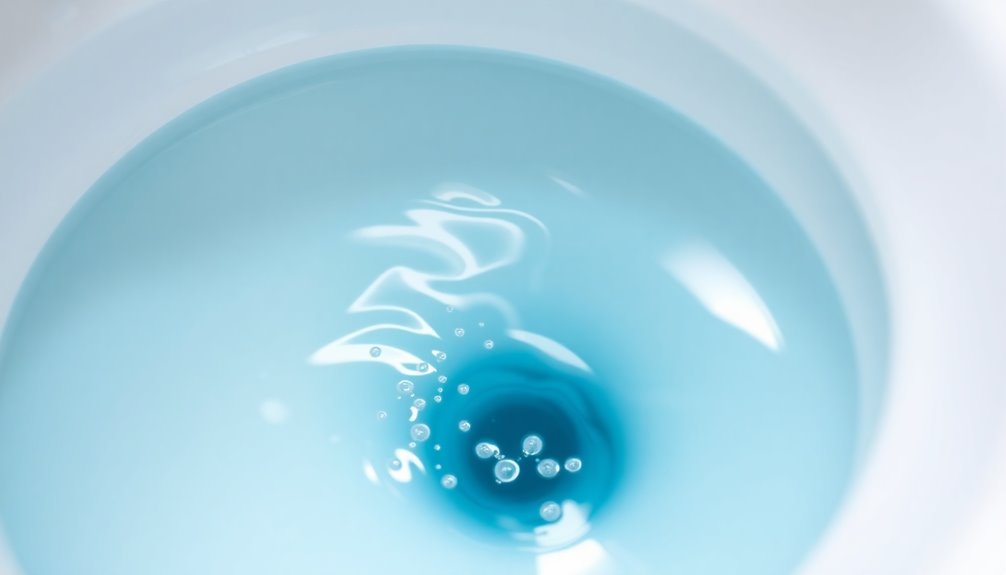
When you're dealing with toilet water behavior, it's vital to understand how various factors can affect the water level in your toilet bowl.
A clogged drain can siphon water out, leading to a lower water level. Blockages from tree roots, shifting soil, or even flushing trash can exacerbate this issue. Additionally, tree roots can invade sewer lines, causing significant drainage problems that may not be immediately visible.
Additionally, leaks at the toilet base due to loose bolts or a damaged wax ring can also reduce the water level. Cracks in the toilet bowl may cause continuous water loss, while a deteriorated flapper can fail to seal properly, resulting in a drop in water levels as well.
Addressing these issues promptly is essential to maintain proper toilet function and prevent further complications.
How Gravity Affects Toilets

Understanding toilet water behavior sets the stage for grasping how gravity plays a significant role in toilet function.
The siphon effect created by gravity pulls water down the trapway, efficiently moving waste through the S-shaped pipes. When you flush a gravity toilet, the weight of the water in the tank initiates the process, eliminating the need for power. This design has fewer moving parts, reducing the chances of malfunctions. Moreover, the simple design of gravity flush toilets contributes to their reliability and low maintenance requirements.
Gravity also guarantees proper drainage in plumbing systems, from your toilet to septic tanks and sewer systems. However, if you encounter blockages, it's crucial to call a professional plumber.
Understanding Low-Flow Toilets
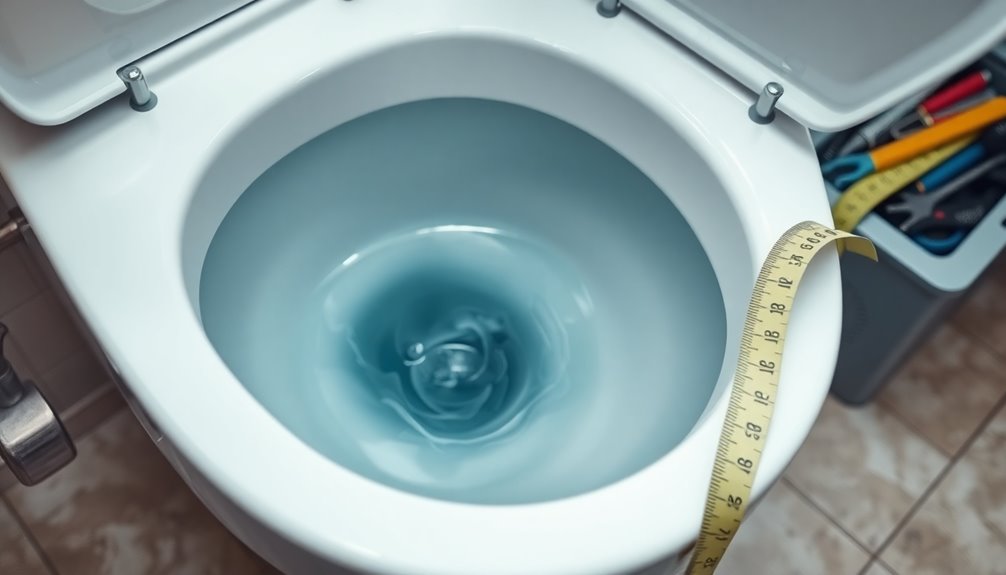
Have you ever wondered how low-flow toilets manage to use less water while still providing effective performance? These toilets typically use no more than 1.6 gallons per flush, with some models using as little as 1.28 gallons.
You'll find single-flush and dual-flush options, with dual-flush toilets offering a reduced flush for liquid waste. Modern low-flow designs have improved markedly, tackling early performance issues through features like pressure-assisted flushing, ensuring powerful waste removal. The adoption of low-flush toilets has contributed to significant overall water conservation efforts across the country.
The US Environmental Protection Agency's WaterSense program certifies these efficient toilets, promoting water conservation. By switching to low-flow models, you can save money on your water bill—up to $90 annually—while doing your part for the environment.
Advantages of Pressure-Assisted Toilets
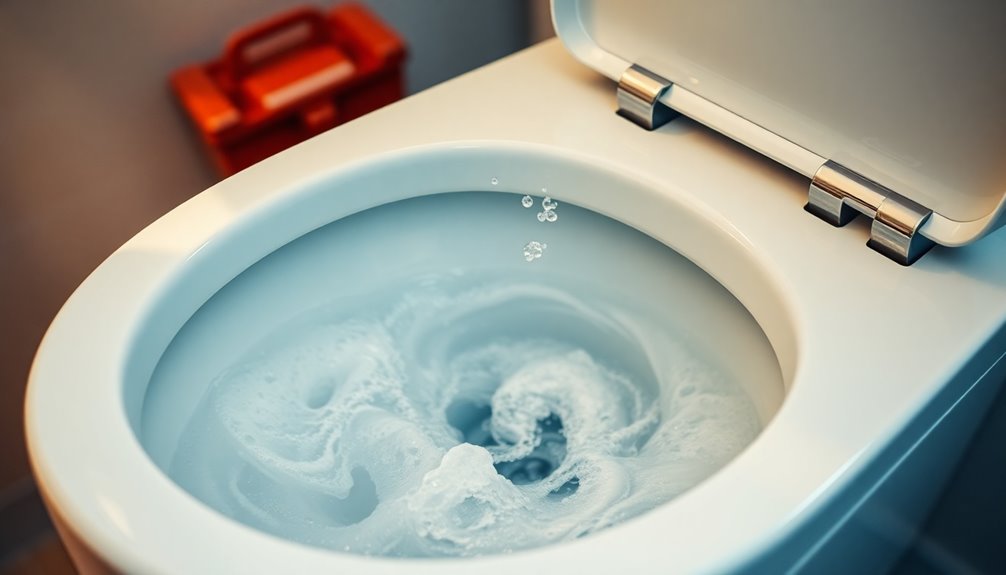
Low-flow toilets are a great step toward water conservation, but if you're looking for even more powerful performance, pressure-assisted toilets could be the answer.
These toilets combine water with pressurized air, delivering superior flushing power that breaks up waste effectively and reduces clogs. You'll appreciate how the high-velocity flush clears waste quickly, often eliminating the need for multiple flushes.
Plus, they use less water—about 1.1 to 1.4 gallons per flush—saving you up to 4,000 gallons a year. Higher velocity flushes also help prevent clogs, making these toilets a smart choice for busy households.
With less frequent cleaning and reduced maintenance needs, these toilets not only improve hygiene but also save you money on repair costs.
Common Plumbing Problems
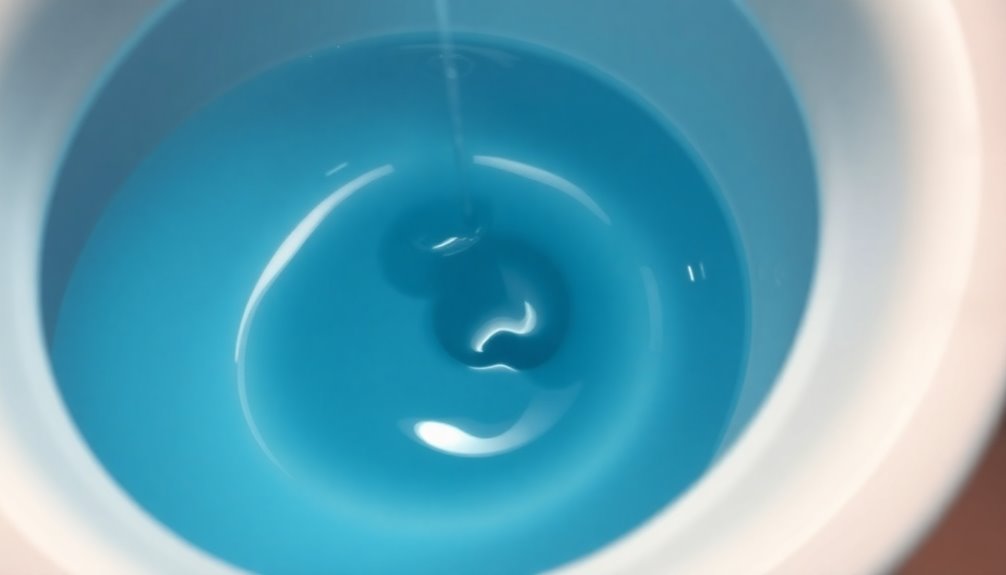
Plumbing issues can sneak up on you, often leading to unexpected headaches and costly repairs. One common problem is faulty faucets, where dripping taps can waste up to 2,600 gallons of water annually. If you notice leaks, check for worn o-rings, bad valve seats, or loose connections. Additionally, a leaking hose bibb can also waste hundreds of gallons monthly, especially if not inspected regularly.
Leaking pipes, especially in older homes, may result from corrosion or high water pressure, often occurring at joints. Toilets can also be troublesome, with internal leaks from faulty flappers or twisted chains, wasting hundreds of gallons daily.
Finally, clogs, whether from hair, food, or non-dissolvable materials, can disrupt your plumbing system. Staying aware of these issues helps you maintain your home's plumbing effectively.
DIY Clog Solutions

When faced with a stubborn clog, you don't have to panic; several effective DIY methods can help you tackle the issue without calling a plumber.
Start with a high-quality plunger, guaranteeing a good seal over the trap opening, and plunge until the clog loosens. If that doesn't work, pour hot water mixed with dish soap into the bowl, wait 10-15 minutes, then flush.
For tougher clogs, try baking soda and vinegar—let the fizzing action sit for up to an hour. A wet/dry vacuum can be a last resort to suck out the blockage.
Finally, if needed, use a wire hanger to prod the clog free. Remember to flush multiple times to guarantee it's completely cleared! Additionally, understanding the common causes of clogs can help you prevent future issues.
Identifying Water Level Issues

If you notice your toilet isn't flushing effectively, it could be struggling due to low water levels. Common causes include a clogged drain, which siphons water out, or a damaged fill tube that prevents the tank from filling properly. Check the float adjustment, as an incorrectly set float can result in insufficient water. Maintaining the optimum water level is crucial for preventing clogs and ensuring effective flushing. You might also see signs like weak flushes, frequent clogs, or gurgling noises. A sudden drop in water level or visible leaks at the base can indicate more serious issues. Investigate the fill valve, inspect for leaks, and verify the vent pipe is clear. If problems persist, don't hesitate to call a plumber for professional help.
Importance of Regular Maintenance
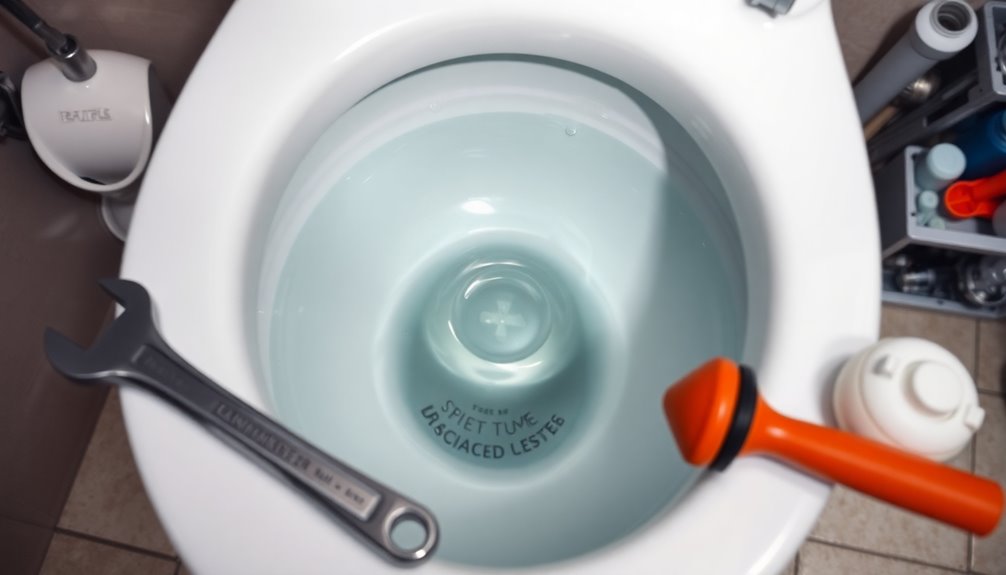
Regular maintenance is essential for keeping your toilet in top shape, as it helps you catch small issues before they turn into costly repairs. By identifying minor problems early, you can reduce the need for expensive fixes and extend your toilet's lifespan. Additionally, regular maintenance can help you establish clear savings goals for your home plumbing expenses.
Regular checks guarantee your toilet operates efficiently, minimizing water waste and avoiding disruptions in your daily routine. Plus, well-maintained toilets uphold hygiene standards and help prevent leaks that could cause water damage. Implementing effective toilet maintenance contributes to overall facility health and safety, ensuring a clean and functional restroom environment.
Inspecting for common issues, like mineral deposits and worn-out parts, will further enhance performance. Overall, routine maintenance saves you money, time, and stress while guaranteeing your toilet runs smoothly for years to come.
Replacing Old Toilets
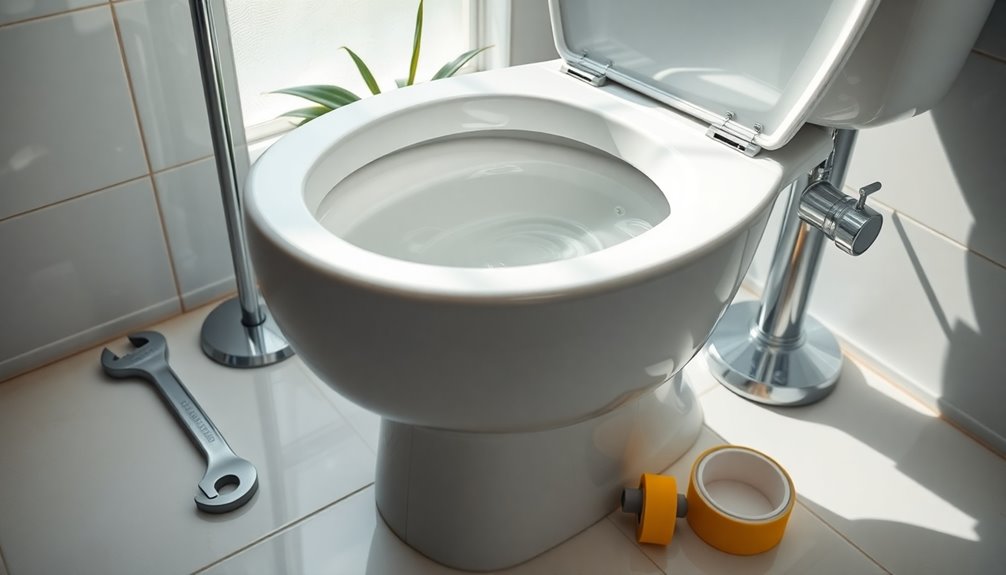
Replacing an old toilet can seem intimidating, but with the right approach, it's a manageable task that can greatly improve your bathroom's efficiency and aesthetics.
Start by shutting off the water supply and disconnecting the supply line. Flush the toilet to empty the tank and bowl, then remove the tank by unscrewing the nuts.
Next, lift the toilet off the flange and clean the area thoroughly. Before installing your new toilet, measure the rough-in distance from the wall to guarantee a proper fit. Make sure to inspect the floor flange for any damage, as a corroded flange will need to be replaced to ensure a secure installation.
Place new closet bolts and a wax ring on the flange, then lower the bowl and tighten the bolts in a star pattern.
Finally, reconnect the water supply and secure everything in place.
Preventing Future Plumbing Issues
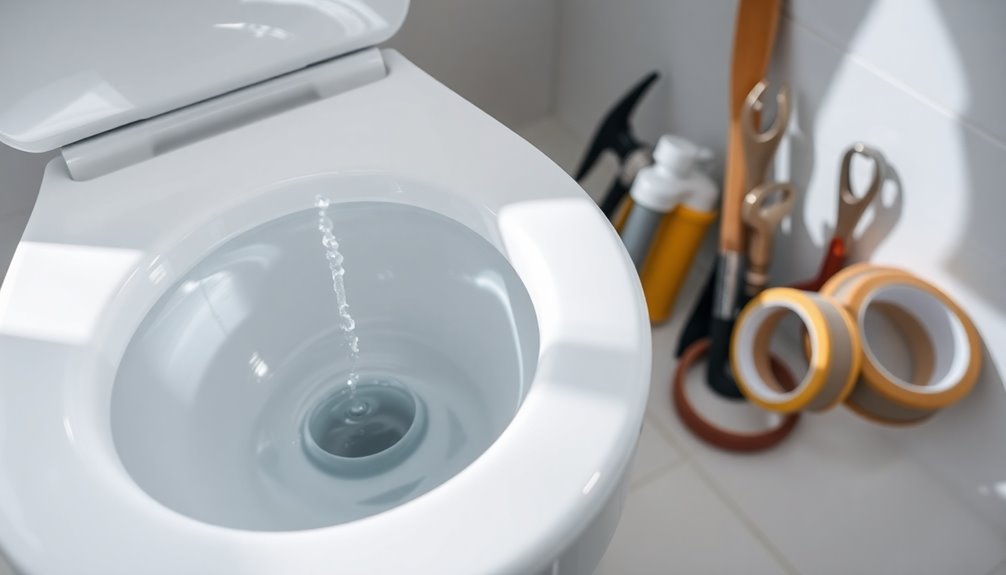
To keep your plumbing system in top shape, proactive measures are essential.
Schedule regular inspections with a professional plumber to catch potential issues early, ensuring your system's longevity. Additionally, these inspections can help ensure your plumbing system's compliance with local codes and standards.
Educate everyone in your household about proper usage practices—avoid flushing inappropriate items like paper towels and wipes to prevent clogs.
Regularly clean drains using natural remedies like baking soda and vinegar, and install drain covers to minimize debris buildup.
In winter, protect pipes from freezing by insulating them and allowing faucets to drip slightly.
Finally, monitor your water pressure; consider installing a pressure regulator to avoid stressing your pipes.
Addressing these factors can help you prevent future plumbing issues and save you time and money in the long run.
Frequently Asked Questions
How Often Should I Replace My Toilet Flapper?
You should replace your toilet flapper every two to three years, but it's wise to check it annually.
Look for signs of wear like mineral buildup, leaks, or a continuous running sound. If your toilet flushes on its own or takes a long time to fill, that's another clue.
Regular inspections will help you catch issues early and save water, so keep an eye on your flapper's condition!
Can I Flush Non-Biodegradable Items Down the Toilet?
You shouldn't flush non-biodegradable items down the toilet. Doing so can lead to serious plumbing issues, causing clogs that can be costly to fix.
Items like wipes, tampons, and plastic bags can damage your home's plumbing and wastewater treatment facilities. Instead of flushing, dispose of these items in the trash to avoid unnecessary repairs and protect the environment.
It's a small change that makes a big difference in maintaining your plumbing system.
What Are the Signs of a Failing Toilet Tank?
When it comes to recognizing a failing toilet tank, watch for a few key signs.
If you notice constant running water, slow refills, or weak flushes, your tank might be struggling.
Check for water pooling around the base or any visible leaks.
You should also be alert for hissing sounds or unexpected spikes in your water bill.
Identifying these issues early can save you from bigger problems down the line.
How Does Toilet Water Temperature Affect Flushing?
Toilet water temperature can greatly affect flushing.
When the temperature drops, it can cause a surge of cold water that momentarily interrupts the pressure balance in your plumbing. This diversion might lead to sudden temperature spikes in your shower, making it uncomfortable or even dangerous.
If you notice these fluctuations, consider installing a thermostatic mixing valve to help maintain consistent temperatures and improve your overall plumbing experience.
Are There Eco-Friendly Toilet Options Available?
Yes, there are several eco-friendly toilet options available.
You can choose low-flow toilets, which use up to 60% less water than traditional ones.
Dual-flush toilets offer you two flushing options for even more savings.
If you're looking for something innovative, consider composting or incinerating toilets, which operate without water.
Bidet toilets enhance hygiene while reducing toilet paper waste.
Each of these options helps you conserve water and reduce your environmental footprint.
Conclusion
To sum up, understanding how toilet water behaves can help you tackle common plumbing issues effectively. By recognizing the role of gravity, maintaining your toilet, and knowing when to replace old models, you can prevent future problems. Embrace the advantages of low-flow and pressure-assisted toilets for better efficiency. With regular maintenance and a little know-how, you'll keep your plumbing running smoothly and avoid unnecessary headaches. Remember, a well-cared-for toilet is key to a hassle-free bathroom experience!
